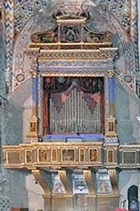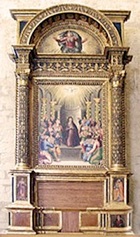

This family from Gubbio produced three generations of important woodworkers in the 16th century.
Relevant Members of the Family
Luca Maffei (died before 1546)
Luca Maffei is first documented in 1472, when he was enrolled in the Arte dei Falegnami (woodworkers’ guild). He held political office in 1508, 1521, 1522 (as one of the consuls of the Quartiere di San Pietro) and 1524.
Giacomo Maffei (died after 1575)
Giacomo Maffei , the son of Luca, held political office in 1534, 1558 and 1566, the year in which he bought a house in the Quartiere di San Pietro. He had four sons, two of whom (Antonio and Giovanni Battista - below) followed professionally in his footsteps. Another son, Luca was wool merchant and moved to Todi.
Girolamo Maffei (died 1594)
Girolamo Maffei, the brother and collaborator of Giacomo (above), was known as “Recanato”, which suggests an association with the Marche. He was “Capitano” of the Arte dei Falegnami in 1546, 1553, 1566 and 1567 and was one of the consuls of Gubbio in 1573.
Antonio Maffei (died 1601)
Following the passing of his father Giacomo and that of his uncle, Girolamo, Antonio became the head of the Maffei workshop. He was described by a contemporary as: ““homo celeberrimo nell’intaglio et stimato da Francesco Maria, Duca d’Urbino per la cui virtù ha fatto esente la sua casa da ogni gabella” ( a man famed for his wood carving and so esteemed for his virtue by Duke Francesco Maria of Urbino that his household is exempt from all taxation). In addition to his work in Gubbio, he secured important commissions in the Marche (Fabriano, Jesi) and in Todi (below).
Later Members of the Family
Giovanni Battista Maffei is documented as an assistant to his father Giacomo and then of his brother, Antonio.
Two of the eleven sons of Girolamo Maffei, Faustino and Francesco, followed in the family tradition.
Work of the Maffei Family in Gubbio
Tabernacle (1529)
This documented tabernacle in San Fancesco by Luca and Giacomo Maffei no longer survives.
Work in the Duomo
In 1548-51, Giacomo and Girolamo Maffei received payments for for a series of wooden structures in the Duomo. These were commissioned by Bishop Marcello Corvino (1544-55), who reigned as Pope Marcellus II for a few months before his death in 1555. The project included:
-
✴in the presbytery:
-
•the choir stalls;
-
•the bishop's throne, which bears the arms of Bishop Giacomo Savelli (1555-61); and
-
•the organ casing and associated choir (below); and
-
✴in a chapel belonging to Pietro Paolo Gabrielli.
Organ Casing and Associated Choir (1548-51)

-
✴As noted above, Giacomo and Girolamo Maffei received payments for the organ casing in 1548-51.
-
✴Pietro Paolo Baldinacci and Benedetto Nucci are documented in relation to its painted panels (ca. 1549). These are probably:
-
• those in the cimasa, which depict the arms of Bishop Marcello Corvino and two reclining angels; and
-
•those at the bases of the columns to the sides of the organ, each of which depicts a personification of a Virtue.
Canon Alessandro Zeccadoro commissioned from “mastro Perino” seven sculpted figures personifying the Liberal Arts for the organ casing. These figures no longer survive, but they were probably originally in the choir under the casing on the right: they seem to be depicted here in the fresco (1654-8) of Bishop Sperelli’s consecration of the Cappella del Santissimo Sacramento, which is in the lunette on the left wall of that chapel. If this hypothesis is correct, the present painted panels in the right choir, which are attributed to Benedetto Nucci, must have been reused from another location.
The organ by Lesichius no longer survives: Bishop Vincenzo Massi commissioned the present organ from Angelo Morettini in 1833.
Seats of the Magistrates (ca. 1555)
These seats (under the organ on the left) might well have been begun as part of the work for which Giacomo and Girolamo Maffei were paid 0n 1548-51. However, they bear the arms of Bishop Giacomo Savelli (1555-61), which suggests that they were completed soon after 1555. They contain fictive intarsia panels (1557) that are signed by Benedetto Nucci and dated by inscription (on the 7th seat on the right).
Tabernacle (1555-61)
Girolamo Maffei received payments for this tabernacle for the high altar of San Pietro in 1553. There seems to have been some dissatisfaction with its design, and a new design was commissioned from Giorgio Vasari in 1555. In 1559, Girolamo and his brother Giacomo Maffei were commissioned to complete it. It was destroyed in 1680.
Altarpiece Frame (1563)

Wooden Statues (1563)
Five documented figures that were carved by Giacomo Maffei for the pulpit in the refectory of San Secondo no longer survive.
Seats (1569)
The Commune commissioned Giacomo and Girolamo Maffei to construct the “seggione” of the Sala Grande of Palazzo del Popolo. [Fragments survive in the Pinacoteca Civica ??]
Altarpiece (1576-9)
This documented altarpiece by Virgilio Nucci from Sant’ Antonio da Padova and its frame, which is attributed to Antonio Maffei, no longer survives. It depicted:
-
✴the Adoration of the Magi; and
-
✴the Visitation and the Annunciation above.
Tabernacle (ca. 1577)
This tabernacle in Santa Maria Nuova was moved there from Sant’ Agostino in 1920. Bishop Mariano Savelli commissioned its gilding in 1577 and a will of 1583 provided for its ornamental housing (which suggests that it was finished by then). It is attributed to Faustino Maffei or (more recently) to Antonio Maffei.
Organ casing and choir (1580-4)
In 1580, the monks of San Pietro commissioned a new organ from the counter-facade of their church. They also commissioned an ornamental casing for the instrument and an associated choir from Antonio and Giovanni Battista Maffei. “Mastro Cosmo dal Borgo” (perhaps Cosmo Alberti, from Borgo Sansepolcro) was paid in 1584 for the nine polychrome statues of Muses in the niches of the choir below. The casing includes the arms of Pope Gregory XIII and those of the Olivetan Order. The structure was modified in 1686, when the chapels to the sides were closed to make way for the extension of the choir. It survives in situ, although the organ itself does not.
Crucifix (1581)
This crucifix, which was commissioned from Antonio Maffei by the monks of San Pietro no longer survives. That is particularly unfortunate because we have no other example of his work as a sculptor.
Work in Santa Maria del Suffragio (late 16th century)
These carved wooded fitments in Santa Maria del Suffragio a San Marco, which are attributed to Antono Maffei, comprise:
-
✴four altars (1581), which are dated by an inscription on one of them (the 2nd on the left); and
-
✴the balustrade on the counter-facade, which is dated from a fragmentary inscription to the 1590s (159...)
Since the church was built in the 17th century, the fitments must have been moved here from another location.
Work in Palazzo Bentivogli (16th century)
Palazzo Bentivogli (later Palazzo Barbi) now houses a delicatessen, Renato Lugni Alimentari. The upper part of the wooden door is attributed to Antonio Maffei.
Marriage chests (16th century)
A pair of marriage chests in the Getty Museum, Los Angeles were documented here in 1643. They are carved in walnut and were originally partly gilded. A note inside says that they were gifts for the marriage of Cesare Bentivoglio and Pressilla de' Conti (which occurred in 1528). It adds that they were made by the “celebre scultore Maffei”, which was probably a reference to Antonio Maffei. However, the authenticity of this note has been questioned. The coat of arms that appears below the lock in the center of each of them belongs to the Conti family, and it is possible that the chests were made by a woodworker in their home city of Foligno.
Franciscan altarpiece (early 17th century)
This altarpiece, which came from San Francesco is which is now in the Pinacoteca Civica, is attributed to Felice Damiani and its frame is attributed to Giovanni Battista Maffei.
Perugia
Organ Casing (1561)
Giacomo Maffei was commissioned to carve the organ casing of Sant’ Agostino, but this work was subsequently destroyed.
Todi
Choir stalls (1581-90)
These new stalls were built by Antonio Maffei along the wall of the apse of San Fortunato after the demolition of the original choir. The work got off to a slow start, but was helped along by a bequest from a lady called Gentilisca di Mello di Collepepe in 1585. The inscription on the stalls reads: “Antonius Maffeis de Augubio fecit MDXC”. The backs of the first three stalls on each side, and of the bishop’s seat at the centre, have wooden bas-relief statues of patron saints in niches.
Read more:
I have made extensive use of the thesis (2008) of Dott.ssa Lorenzina Gambella of the University of Perugia (Facoltà di Lettere e Filosofia):
F. Marucci, “ Contributo alla Storia dell’ Arte Lignaria Eugubina del XVI Secolo: l’ Ornamentazione degli Organi Monumentali del Duomo e di San Pietro in Gubbio” in:
C. Galassi (Ed.), “L’ Arte del Legno tra Umbria e Marche: dal Manierismo al Rococò” (2000) Perugia, pp 95-110

